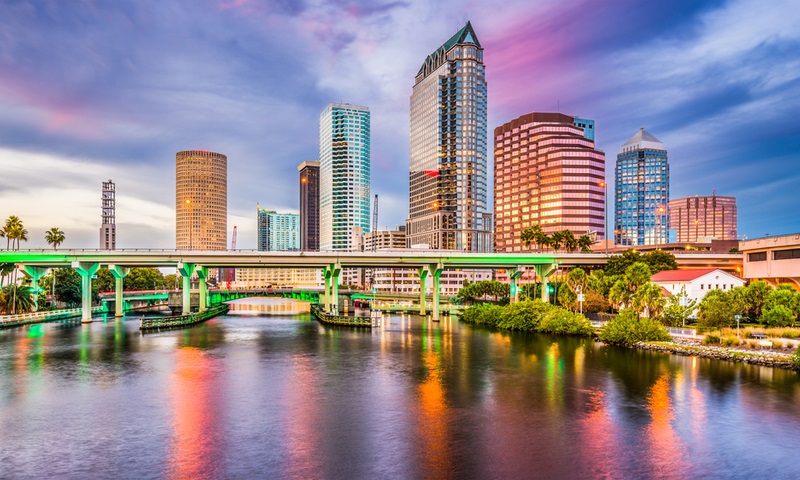
Cities across the nation have been handling the economic effects brought on by the pandemic in different ways. Some focused on reviving the tourism industry, and others took the sustainability road. At the same time, cities like Tampa, Florida, concentrated on multiple factors to ensure stable and sustainable growth for their residents and businesses.
Last year, real estate experts and economists analyzed how the city overcame the struggles and determined that 2020 had been a year of growth for Tampa’s real estate market. Upon further inspection, they concluded that 2021 is expected to bring further growth in Tampa’s industry as the real estate market remains hot.
The cost of professional and business services grew, leading to bigger profits for companies that expanded their offices and created more job opportunities. Naturally, with more employees, the demand for housing grew not only in Tampa but in all of Hillsborough County. To all of this, we add the city’s growing quality of life, location, and Tampa slowly becoming the country’s envy.
The economy of any city depends on diverse factors and developing the most influential factors leads to a strong market overall. Because of this Tampa is considered one of the best places to live. We’ll take a closer look at how things evolved in Tampa in every factor of interest and understand how any city can influence its growth through careful and strategic planning.
Population Growth
Looking at the population growth of Tampa, Florida, and its surrounding area in Hillsborough County, we can see an increase of 459,000 residents over the last ten years based on statistics from macrotrends[dot]net. Projections show that the Tampa metropolitan area’s population is expected to exceed 3,188,000 by 2030, even if the growth rate has dropped slightly since 2018.
Currently, the city of Tampa, FL is the third-largest in the state, behind Miami and Jacksonville by a big difference. Only in Tampa, FL, there are approximately 400,000 residents, but there has been a registered growth of 18.9% since 2010.
Job Market
Last year was a year of growth for new job opportunities across the whole state, but Tampa led the way with over 30,400 new jobs in the private sectors, of which 8,000 were only in construction. The economy’s stable growth can also be seen in other important employment sectors in Tampa, such as government, manufacturing, and financial services showing significant signs of job growth.
The effect of this trend in job growth can be seen in the metropolitan area’s gross domestic product (GDP) of more than $169 billion. Compared to ten years ago, the Tampa Metropolitan Area’s GDP nearly doubled, leading to employment growth of 2.5% over the last 12 months. The unemployment rate went down to 5.6% during this time as well.
Through expansion and recovery, industries in Tampa are expected to increase the city’s job growth. Some of the industries that experienced high growth over the last decade are informational technology (Verizon Communication), life science and healthcare (BayCare Health Care Systems), distribution and logistics (Publix Super Markets Inc.), and manufacturing. Related to distribution, Tampa also has the Port of Tampa Bay that is the largest seaport in the state. The Tampa Metropolitan Area is serviced by Tampa International Airport, St. Petersburg-Clearwater International Airport, and Sarasota-Bradenton International Airport, with over 90 domestic and international destinations non-stop bringing tourists and services to the area’s population.
Real Estate Market
Tampa’s real estate market transformation to a seller’s market didn’t come as a shock to investors who could forecast based on previous years’ performances that 2021 will continue the trends. Based on Zillow’s statistics, we can see that Tampa’s current median home value almost reaches $300,000 after it experienced a 15.3% growth since last year. Prices are expected to continue to grow by 7.5% by 2022. Despite these appreciation trends and the strong seller’s market, home sales in the city are also expected to grow by 8.7%
With more people interested and drawn to the city’s growing economy, the demand for housing grows. This leads to multiple offerings on a home purchase, negotiations, and the potential for prices to rise. If you’re interested in relocating to Tampa, Florida, it would be best to understand how prices are affected by good growing trends in a city’s economy. With the help of local real estate agents in Tampa FL, you have a better chance to purchase a home without worrying about paying more than the asking price. That can happen, but as 99.3% of homes were sold for approximately the asking price, it’s best to work with a professional in a market like this.
Attractive Market for Renters
A side-effect of a competitive housing market is that not all interested buyers can manage to become homeowners. This drives the demand for rental properties in Tampa’s metropolitan area higher. Especially first-time homebuyers are left struggling because of the low housing inventory, but the rental market is offering accessible options. Because of this, institutional investors manage many rentals in this metropolitan area.
The average rental in Tampa, FL, is affordable enough at $1,400 per month with a 6% increase over the last 12 months. The rate for renters versus owners increased and is 53%, while only 47% of Tampa residents are owners.
Housing Affordability and Price Changes
By analyzing the housing affordability and the rate at which prices change, real estate investors can anticipate the demand for rental properties in the future for a specific area. Based on these analyses, investors determined that property prices in Tampa, FL, suffered a 58.2% 5-year change. The annual change is at 12.9%, while the monthly change is at 1.8%.
In order to forecast current and future demands for rental properties in Tampa, investors research housing affordability. Affordability can be determined by comparing Tampa’s median home value to the annual income necessary to make the purchase. This analysis established that the affordability for housing purchase in Tampa is mid-range, explaining the growing rental market in the city.
Conclusion
Determining the factors determining a city’s growth or decline is helpful for any potential investor in a city. Regardless of whether the investment goes beyond homeownership, these factors give investors the information needed to make the best decision for themselves, their business, and their finances. Any potential home buyer is looking at growth trends in the real estate market, but those are just one factor influencing a city’s economy. Suppose they want to determine whether they’ll have a good quality of life, a good work-life balance, financial stability, and opportunities to grow. In that case, they should pay attention to a multitude of factors.
A city’s cost of living doesn’t show the most accurate image of a city’s quality of life. Similarly, high incomes don’t necessarily mean that you’ll be safe in that city. The information from this article gives a general idea of what one individual can expect from living or working in the city of Tampa. Is everything perfect? We can’t give an affirmative answer to that question. But the trends show a strategic and sustainable growth plan has been in place for a while, results can be seen, and the city’s quality of life is growing. The rest is up to the reader.
http://bios.edu/?URL=https://www.anyxxxtube.net/video/3869/indian-sex-video-ful-hd/
https://cse.google.com.pk/url?sa=t&url=https://www.bangbf.com/video/2932/tamil-doggy-style-sdx/
https://clients1.google.co.im/url?q=https://www.anyxxxtube.net/video/3792/bhabhi-porn-photos/

